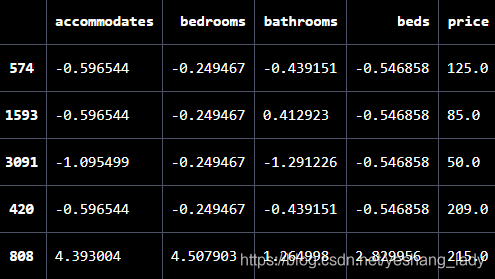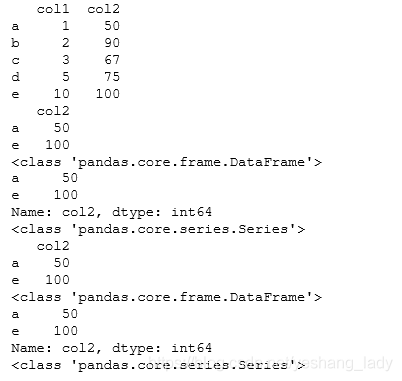pandas中對DataFrame篩選數(shù)據(jù)的方法有很多的�����,以后會后續(xù)進行補充,這里只整理遇到錯誤的情況�。
1.使用布爾型DataFrame對數(shù)據(jù)進行篩選
使用一個條件對數(shù)據(jù)進行篩選,代碼類似如下:
num_red=flags[flags['red']==1]
使用多個條件對數(shù)據(jù)進行篩選����,代碼類似如下:
stripes_or_bars=flags[(flags['stripes']>=1) | (flags['bars']>=1)]
常見的錯誤代碼如下:
代碼一:
stripes_or_bars=flags[flags['stripes']>=1 or flags['bars']>=1]
代碼二:
stripes_or_bars=flags[flags['stripes']>=1 | flags['bars']>=1].
代碼三:
stripes_or_bars=flags[(flags['stripes']>=1) or (flags['bars']>=1)]
以上這三種代碼的錯誤提示都是:ValueError: The truth value of a Series is ambiguous. Use a.empty, a.bool(), a.item(), a.any() or a.all(). 中括號里面的邏輯式如何解析的暫時不清楚。貌似不能使用and��、or及not���。
除了使用組合的邏輯表達式之外����,使用返回類型為布爾型值的函數(shù)也可以達到篩選數(shù)據(jù)的效果��。示例如下:
import pandas as pd
import numpy as np
df=pd.DataFrame(np.array(range(10)).reshape((5,-1)))
df.columns=['0','1']
df=df[df['1'].isin([3,5,9])]
其df的結(jié)果如下:

2.iloc()方法����、ix()方法和iloc()方法的區(qū)別
首先dataframe一般有兩種類型的索引:第一種是位置索引,即dataframe自帶的從0開始的索引��,這種索引叫位置索引��。另一種即標簽索引�,這種索引是你在創(chuàng)建datafram時通過index關(guān)鍵字,或者通過其他index相關(guān)方法重新給dataframe設(shè)置的索引���。這兩種索引是同時存在的�����。一般設(shè)置了標簽索引之后�����,就不在顯示位置索引����,但不意味著位置索引就不存在了�。
假設(shè)有如下幾行數(shù)據(jù)(截圖部分只是數(shù)據(jù)的一部分),很明顯����,以下顯示的索引為標簽索引���。同時574(標簽索引)行對應(yīng)的位置索引則為0,1593行對應(yīng)的位置索引為2�����, 以此類推�����。

先來看loc(),其API網(wǎng)址http://pandas.pydata.org/pandas-docs/stable/reference/api/pandas.DataFrame.loc.htm�,函數(shù)名下方有一行解釋,Access a group of rows and columns by label(s) or a boolean array.. loc[] is primarily label based, but may also be used with a boolean array.
代碼一:
first_listing = normalized_listings.loc[[0,4]]
結(jié)果如下��,可以看出其輸出的是dataframe中標簽索引為0和4的兩行數(shù)據(jù)��。注意��,如果標簽索引的類型為字符串���,則在loc中也要用字符串的形式�����。

再來看iloc(),其API網(wǎng)址http://pandas.pydata.org/pandas-docs/stable/reference/api/pandas.DataFrame.iloc.html�,函數(shù)名下方的解釋為 Purely integer-location based indexing for selection by position. .iloc[] is primarily integer position based ( from 0 to length-1 of the axis), but may also be used with a boolean array.
代碼二:
first_listing = normalized_listings.iloc[[0,4]]
結(jié)果如下���,可以看出其輸出的dataframe中第0行和第4行的數(shù)據(jù)���,即按方法是按照位置索引取得數(shù)。注意使用位置索引的時候只能用整數(shù)(integer position,bool類型除外)

另外����,還可以向loc和iloc中傳入bool序列,這樣就可以將前面介紹的boo表達式用到loc和iloc中�����。下面來看看怎么使用bool序列��?
import pandas as pd
data=pd.DataFrame(data={'col1':[1,2,3,5,10],'col2':[50,90,67,75,100]},\
index=['a','b','c','d','e'])
print(data)
#iloc[]示例,iloc似乎不能直接使用邏輯表達式的結(jié)果�,我這里將其轉(zhuǎn)置成list之后就可以用了,原因暫且不明
data_1=data.iloc[list(data['col1']>5)]
print(data_1)
#loc[]示例����,loc中可以直接使用邏輯表達式
data_2=data.loc[data['col1']>5]
print(data_2)
在iloc[]中,如果直接使用loc中的邏輯表達式而不進行l(wèi)ist()轉(zhuǎn)化的話,會提示ValueError: iLocation based boolean indexing cannot use an indexable as a mask錯誤��。
如果查看上述兩段代碼中得到的first_listing��。我們會發(fā)現(xiàn)兩處first_listing的類型均為datafrarm����。loc和iloc除了能對行進行篩選,還可以篩選列����。如果在loc和iloc中設(shè)定了對列的篩選,則篩選之后得到的數(shù)據(jù)可能是datafrme類型�,也有可能是Series類型。下面直接以代碼運行結(jié)果進行說明���。
import pandas as pd
data=pd.DataFrame(data={'col1':[1,2,3,5,10],'col2':[50,90,67,75,100]},\
index=['a','b','c','d','e'])
print(data)
#iloc[]示例 ,在使用iloc的時候��,[]里面無論是篩選行還是篩選列�����,都只能使用數(shù)字形式的行號或列號�。
#這里如果使用‘col2',這里會報錯
data_1=data.iloc[[0,4],[1]]#當需要篩選出多列或者希望返回的結(jié)果為DataFrame時�����,可以將列號用[]括起來。
print(data_1)
print(type(data_1))
data_2=data.iloc[[0,4],1]#當只需要篩選出其中的一列時可以只寫一個列號�,不加中括號,這種方法得到的是一個Series
print(data_2)
print(type(data_2))
#loc[]示例
data_3=data.loc[['a','e'],['col2']]
print(data_3)
print(type(data_3))
data_4=data.loc[['a','e'],'col2']
print(data_4)
print(type(data_4))
具體的代碼執(zhí)行結(jié)果如下:

最后看ix()方法�����,其API網(wǎng)址http://pandas.pydata.org/pandas-docs/stable/reference/api/pandas.DataFrame.ix.html,其解釋為 A primarily label-location based indexer, with integer position fallback.
代碼三:
first_listing = normalized_listings.ix[[0,4]]
結(jié)果如下似乎與loc()方法的結(jié)果是相同的��,但是從其給出的解釋來看���,其好像是前兩個方法的集合。

到此這篇關(guān)于pandas按條件篩選數(shù)據(jù)的實現(xiàn)的文章就介紹到這了,更多相關(guān)pandas 條件篩選 內(nèi)容請搜索腳本之家以前的文章或繼續(xù)瀏覽下面的相關(guān)文章希望大家以后多多支持腳本之家���!
您可能感興趣的文章:- pandas 按日期范圍篩選數(shù)據(jù)的實現(xiàn)
- 使用pandas實現(xiàn)篩選出指定列值所對應(yīng)的行
- 使用pandas庫對csv文件進行篩選保存
- pandas條件組合篩選和按范圍篩選的示例代碼
- 使用Pandas對數(shù)據(jù)進行篩選和排序的實現(xiàn)
- Pandas 如何篩選包含特定字符的列